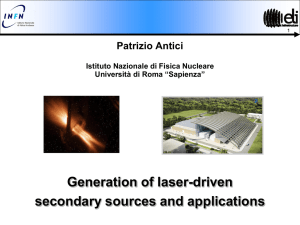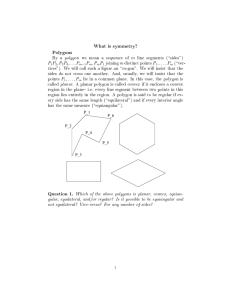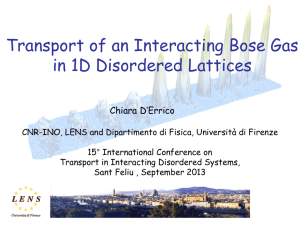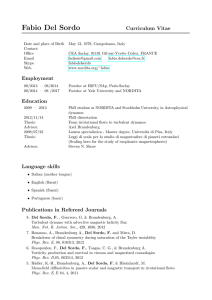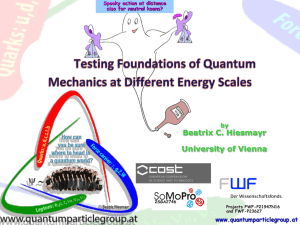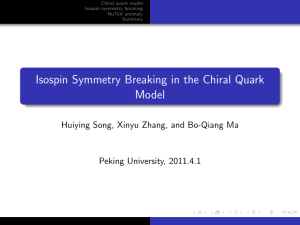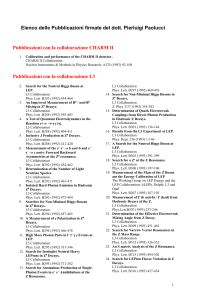基于玻尔兹曼-朗之万方程下重离子碰撞中pion介子的产生
advertisement
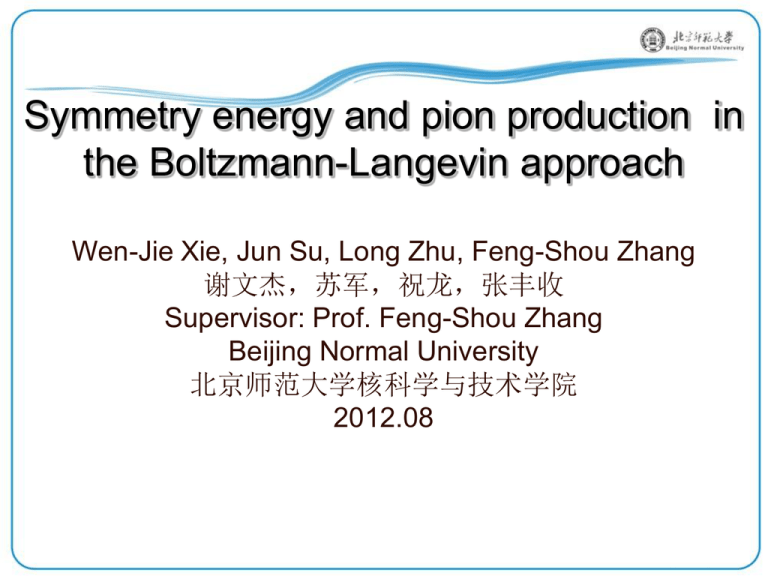
Symmetry energy and pion production in the Boltzmann-Langevin approach Wen-Jie Xie, Jun Su, Long Zhu, Feng-Shou Zhang 谢文杰,苏军,祝龙,张丰收 Supervisor: Prof. Feng-Shou Zhang Beijing Normal University 北京师范大学核科学与技术学院 2012.08 Contents 1. Introduction 2.The isospin- and momentum-dependent Boltzmann-Langevin Model (IBL) 3. The calculated results on the pion production using the IBL model (1) the pion multiplicity (2) the ratio 4. Conclusions Introduction The form of symmetry energy is important in both nuclear physics and astrophysics and not well constrained up to now. At subnormal densities: The symmetry energy increases with increasing the density. At supernormal densities: The trend of the symmetry energy with increasing density is not constrained. Supersoft : IBUU04, Z. G. Xiao, PRL102 (2009) 062502 Superstiff: ImIQMD, Z. Q. Feng, PLB 683 (2010) 140 Among the probes of the symmetry energy, the is promising. The resonance model predicts a ratio of where the N Z 5N NZ 2 5Z 2 NZ N Z 2 is determined by the symmetry energy. R. Stock, Phys. Rep. 135 (1986) 259 , The IBL model 1. The Boltzmann-Langevin equation : p r rU t m fˆ p ˆ f r , p, t K fˆ K r , p , t 2. The evolution equation : 3. The effective potential : V V sky 2 V sky 3 V sym V m di V coul 4. The collision term: 5. The fluctuation term: Qˆ 2 0 r , t t Q 2 0 r , t t tC 2 0 r , t W 2 , Qˆ 3 0 r , t t Q 3 0 r , t t tC 3 0 r , t W 3 . The fluctuation term The fluctuating collision term K r , p , t can be interpreted as a stochastic force acting on f r , p , t t and is charaterized by a correlation funtion, K r1 , p1 , t1 K r2 , p 2 , t 2 C p1 , p 2 r1 r2 t1 t 2 . After using an approximate treatment, the local momentum distribution is projected on a set of low-order multipole moments Q L M of order L with magnetic quantum numbers M . And the C p1 , p 2 can be reduced and written as: C L M L M r , t dp dp 1 2 dpdp Q p Q LM L M p C p, p dp 3 dp 4 Q L M Q L M W 12, 34 f 1 f 2 1 f 3 1 f 4 , F. S. Zhang et al. Phys. Rev. C 51(1995) 3201 E. Suraud et al. Nucl. Phys. A542 (1992) 141 Y. ABE, S. Ayik, et, al. Phys. Rep. 275 (1996)49 The scaling procedure The scaling procedure used to rescale the local momentum distribution to the local values of Qˆ 2 0 r , t and Qˆ 3 0 r , t is given in the following pz 0 : p z p z , p p ; pz 0 : pz pz , p p . The , , are solved in terms of the following equations: 2mE 2 2 pz 2 2 2 2 Q 30 2 3 p 2 2 pz 0 pz Q 20 2 2 2 pz 2 2 2 p p z 3 3 2 2 p pz 0 2 p 2 p 2 2 p 2 px p , , 2 F. S. Zhang et al. Phys. Rev. C 51(1995) 3201 2 p z p . The evolution process of IBL 1. Starting with a definite density f r , p , t at time t , the first step is to determine the local average evolution from t to t t , which yields f r , p , t t and the elements of the diffusion matrix C L L r , t . 2. The diffusion matrix is diagonalized and the fluctuations are calculated. 3. The fluctuations are inserted into the single-particle density. The above three steps are repeated at each time step. The differences between the IBL and usual BUU models Vlasov: 演化过程只受哈密顿 方程的约束,每次事件模拟 的状态确定,不需做多次事 件模拟。 BUU: Vlasov+ 随机碰撞,尽 管碰撞具有随机性,但平均 路径是一样的,只能讨论单 体观测量。 BLE:BUU+ 涨落,涨落的效 果是在每一步演化的过程中 加一随机量,使得系统每次 演化的路径不一样,使得模 型可以讨论除单体观测量意 外的其他观测量 A. Ono, J. Randrup, Eur. Phys. J. A 30 (2006) 109 The differences between the IBL and usual BUU models 500 500 400 Q20+20 300 -2 Q20-20 -2 Q20 (fm ) 300 Q20 (fm ) BUU: 动量四极距是确定的 BLE:由于涨落的存在,动量四极 距值有较大的变化范围 Q20 400 (a) Q20+220 200 Q20-220 100 200 Q20 0 0 20 Q20+20 100 40 60 t (fm/c) Q20-20 0 Q20+220 Q20-220 -100 50 (b) -2 20 (fm ) 40 IBL BUU 30 20 10 0 0 10 20 30 40 50 60 t (fm/c) The 20 Q 20 Q 20 2 2 is the standard deviation function. The forms of the symmetry energy 100 80 Esym (MeV) E sym ( ) 38.9 18.4 0 0 soft linear hard supersoft E sym ( ) 14.7 0 60 40 20 0 0 1 2 3 4 /0 Z. Q. Feng, G. M. Jin, Phys. Lett. B 683 (2010) 140 s 2.14 3.8 0 5/3 Pion multiplicity 100 100 10 M() M() 10 FOPI data IBL SM IBL HM 1 1 0.1 0.2 0.4 0.6 0.8 1.0 FOPI data supersoft soft linear hard 0.2 1.2 Ein (GeV/nucleon) 100 M() 10 FOPI data IBL BUU Xiao PRL09 1 0.1 0.2 0.4 0.6 0.8 1.0 1.2 Ein (GeV/nucleon) W. Reisdorf, et, al., Nucl. Phys. A 781(2007) 459 Z. G. Xiao, et, al. ,Phys. Rev. Lett. 102 (2009) 062502 0.4 0.6 0.8 1.0 Ein (GeV/nucleon) 1.2 The dependence of the ratio on the N/Z at 400A MeV 4.0 3.5 FOPI data supersoft soft linear hard 3.0 3.0 96 197 Au+ Au 96 Zr+ Zr 2.5 (N/Z) + / 2.0 - - / + 2.5 197 FOPI data IBL BUU 3.5 2.0 1.5 1.5 96 40 2 96 Ru+ Ru 40 N/Z Ca+ Ca 1.0 1.0 1.0 1.2 1.4 1.6 0.5 1.0 N/Z W. Reisdorf, et, al, Nucl. Phys. A 781(2007) 459 R. Stock, Phys. Rep. 135 (1986) 259 1.2 N/Z 1.4 1.6 The excitation function of 5 5 FOPI data supersoft soft linear hard 4 / + + 3 - - from central Au+Au collisions FOPI data IBL BUU 4 / 2 0.0 3 2 0.2 0.4 0.6 0.8 1.0 Ein (GeV/nucleon) 1.2 1.4 0.0 0.2 0.4 0.6 0.8 1.0 Ein (GeV/nucleon) 1.2 1.4 Conclusions 1. 2. 3. The pion multiplicity is dependent on the EOS and independent on the symmetry energy. The pion multiplicity and ratio calculated by the IBL mdoel are larger than those obtained by the usual BUU model at lower incident energies, especially for below the pion threshold value. Calculations with a supersoft symmetry energy describe well the experimental data. Thank you for your attention!
